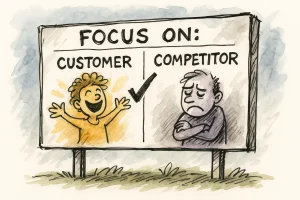
Many companies treat “culture” as a poster on the wall, a nice phrase on the website, or an onboarding day with inspiring presentations. None of that defines who you are. Culture is the experience that leaves through the door: deadlines met (or missed), clear promises (or confusing ones), fast responses (or slow), respect in the little things (or constant excuses). In other words, culture is the effect of your behavior on the life of the person who pays the bill.
The simple culture test
If you want to know your company’s culture, don’t just ask the leaders. Ask the customer:
- Does the phone get answered and the issue solved?
- Is the agreed deadline honored?
- Does the invoice arrive correctly?
- Are mistakes acknowledged without excuses?
- Does after-sales work even when there’s no new purchase?
The answers matter more than any internal manual.
What culture really organizes?
- How decisions are made: what matters more – short-term gains or long-term trust?
- Who gets promoted: those who deliver well and work together, or the “star” who hits targets at the team’s and customer’s expense?
- Where money goes: are there resources for training, documentation, and improving processes, or only for flashy campaigns?
- What is tolerated: “normal” delays, unanswered emails, vague promises? What is tolerated sets the real standard.
Practical examples
- Neighborhood bakery: culture isn’t “we love bread” – it’s fresh bread at 6 a.m., moving queues, and correct change.
- Clinic: culture isn’t “we care for people” – it’s respecting appointments, a reception that informs, and doctors who explain without rushing.
- Software company: culture isn’t “we love innovation” – it’s fast bug fixes, documentation any customer can understand, and support that responds within 24 hours.
How to turn values into visible behavior?
- Translate values into actions:
- “Transparency” becomes a budget without fine print, weekly project status updates, and an open channel for questions.
- “Quality” becomes a delivery checklist, peer reviews, and a standard way to respond to mistakes.
- Create short rituals:
- Monday morning: 15 minutes to align priorities and identify blockers.
- Friday: 15 minutes to recognize three team achievements and record a learning.
- Define metrics the customer can perceive: average response time, on-time delivery, rework rate, NPS or simple ratings. Review these numbers weekly.
- Reinforce what works: publicly acknowledge those who live the culture. Promotions and bonuses should reflect behavior, not just raw results.
- Make the tough choices: a “top performer” who wears out clients and the team contradicts the culture? Keeping them signals that your words mean nothing.
- Admit and correct fast: strong culture isn’t “we never make mistakes”- it’s making fewer mistakes and fixing them quickly. Standard message: “We failed here; we will do X by Y date. Thanks for letting us know.”
Questions to keep culture on track
- What did the customer notice yesterday that confirms who we say we are?
- What behavior did we tolerate this week that contradicts our message?
- What are we measuring that the customer truly experiences?
- Who needs support to deliver the standard we promised?
A 30-day roadmap to make culture visible
- Week 1: list 3 values and describe 2 observable behaviors for each.
- Week 2: choose 3 metrics customers perceive and share them with the team (and, if possible, with clients).
- Week 3: adjust a critical process (support, delivery, or billing) to reflect the defined behaviors.
- Week 4: publicly recognize those who lived the values and document what to improve in the next cycle.
Conclusion
Culture isn’t an internal feeling; it’s the external effect of your repeated choices. It’s how your business treats people, keeps its word, and solves problems. If what you say internally doesn’t appear in the customer experience, it’s not culture—it’s marketing. Do the simple things consistently, measure what the customer experiences, and reward those who uphold the standard. The results show up in cash flow, reputation, and the peace of mind of everyone who works there.





